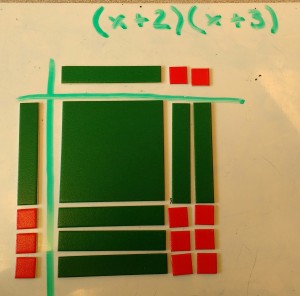How patterns make multiplying and factoring polynomials easier?
- Algebra tiles are helpful when trying to figure out which signs are being multiplied.Whenever there’s a positive and a positive multiplying for example (x+2)(x+3), the algebra tiles will all be colored in.
 Whenever there’s a negative and a positive multiplying for example (x-2)(x+3), the algebra tiles will look like half is colored and half is not.
Whenever there’s a negative and a positive multiplying for example (x-2)(x+3), the algebra tiles will look like half is colored and half is not.
Lastly, whenever there’s 2 negatives multiplying for example (x-2)(x-3), the algebra tiles will look like half colored, half not, half colored and half not.  When factoring polynomials, you have to make sure the second term is half of the first term for example, x^2+5x+6 (the variable in the middle needs to have half of the number of x’s as the leading term). An example that would not factor would be (x^3+5x+6) because x^3 is 3 times x, not 2. How you get x^2 is by multiplying (x)(x), how you get 6x is adding the constants together and x, and finally how you get 8 is by multiplying the constants (so that means the #s have to multiply to one # and add to the other). Notice it’s using the same variable.
When factoring polynomials, you have to make sure the second term is half of the first term for example, x^2+5x+6 (the variable in the middle needs to have half of the number of x’s as the leading term). An example that would not factor would be (x^3+5x+6) because x^3 is 3 times x, not 2. How you get x^2 is by multiplying (x)(x), how you get 6x is adding the constants together and x, and finally how you get 8 is by multiplying the constants (so that means the #s have to multiply to one # and add to the other). Notice it’s using the same variable. 
 Doesn’t matter which order they are in. 2+3+5 gives the same answer as 3+2+5…
Doesn’t matter which order they are in. 2+3+5 gives the same answer as 3+2+5…
 Other quick tips… to factor an equation with only 2 terms, it would have to have conjugates and a negative. Example (x-4)(x+4) = x^2-16 (two terms). And double patterns are a thing!—— x^2+4xy+3y^2=(x+y)(x+3y)
Other quick tips… to factor an equation with only 2 terms, it would have to have conjugates and a negative. Example (x-4)(x+4) = x^2-16 (two terms). And double patterns are a thing!—— x^2+4xy+3y^2=(x+y)(x+3y)

